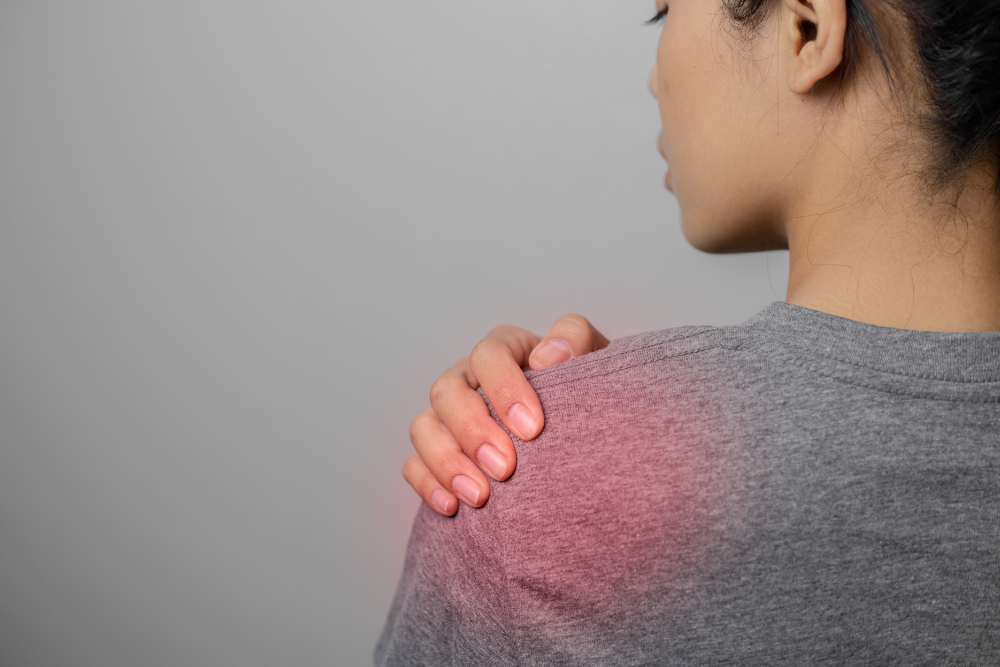
Shoulder pain is one of the most common types of pain that people experience. This ball-and-socket joint where the upper arm meets the shoulder blade is one of the largest, most complex, and dynamic joints of the human body. Whenever we engage our arms in activity, whether it be something simple like typing or something more dynamic like throwing, our shoulders are involved. The shoulders are particularly susceptible to pain and injury due to overuse over time or injury. Here are some of the most common causes of shoulder pain that we treat at The Orthopedic Health Center
1) Shoulder Bone Spurs
Bone spurs are a type of growth that develops on the edge of the bone, most often on the areas where two bones meet. Bone spurs in the shoulder are usually caused by an underlying condition, such as arthritis, but can also be caused by injuries and accidents. They can start to cause pain when they start pressing on nerve endings. In addition to pain, bone spurs in the shoulder can also cause stiffness, weakness, numbness, visible bumps under the skin, tenderness, and swelling.
2) Shoulder Bursitis
Shoulder bursitis is a condition that impacts the bursae, which are small fluid-filled sacs that protect joints from friction. In shoulder bursitis, the bursae that protect the bones, tendons, and ligaments of the shoulder become inflamed, often due to repetitive movement. Common symptoms of shoulder bursitis include visible redness, swelling, achy pains, shoulder stiffness, and pain that increases when you move or press on the shoulder.
3) Labral Tear
The labral is a piece of cartilage (the fibrous rubbery tissue that provides shock absorption for the joints) that lines the rim of the shoulder socket. This cartilage helps prevent the shoulder from slipping out of place. Repetitive motions of the shoulder can cause the labral tissue to tear. Labral tears can also be caused by falling on your shoulder. Common symptoms of labral tears include shoulder instability, pain, the sensation that parts of the shoulder are grinding against each other, and locking.
4) Shoulder Dislocation
When the upper arm bone, known as the humerus, pops out of the shoulder’s socket, it is known as a shoulder dislocation. Shoulder dislocation is often caused by sports injuries and other traumas, such as car accidents. Symptoms of shoulder dislocation include intense pain, swelling, the inability to move the joint, and a visibly out-of-place shoulder.
5) Shoulder Fracture
A shoulder fracture is when any of the bones associated with the shoulder experience a break. Shoulder fractures can happen to the clavicle (collarbone), the scapula (shoulder blade), or the proximal humerus. The severity of pain and impaired function caused by a fractured shoulder largely depends on where the fracture is and how large of a break it is. In general, the symptoms include pain, swelling, tenderness, and the inability to move your arm without pain. You may also see a raised bump in the shoulder localized to where the fracture has occurred.
6) Frozen Shoulder
Also known as adhesive capsulitis of the shoulder, frozen shoulder is a condition that involves the connective tissue that encases the shoulder joint becoming thicker and eventually causing pain and stiffness in the shoulder joint. In the earliest stages of frozen shoulder, the shoulder starts to feel pain during movement and mobility becomes increasingly limited. As time goes on, the pain can sometimes begin to decrease, but the stiffness will continue to increase. At this stage, it may be more difficult to use the shoulder. Finally, the shoulder gradually begins to regain its mobility. The cause of frozen shoulder is not fully understood, but it is most likely to happen to individuals whose shoulder has been immobilized for an extended period of time (e.g. due to a fracture) or those who have certain systemic diseases (e.g. diabetes).
7) Shoulder Impingement
Shoulder impingement is a condition that affects the tendons of the shoulder joint. Tendons are bands of connective tissue that attach bones to muscles, providing the body with the means to move. In shoulder impingement, the tendons of the rotator cuff become irritated or pinched by the shoulder blade. It is most commonly caused by repetitive shoulder motions and lifting overhead. Symptoms can include pain when lifting your arms over your head, achiness at night, pain when reaching behind your back, weakness, and stiffness.
8) Rotator Cuff Tear
The rotator cuff is a group of muscles and tendons that supports the top of the humerus and keeps it firmly in place in the shoulder joint’s socket. It can be torn due to wear and tear or because of an injury, such as falling on an outstretched arm. It can also be exacerbated by repetitive stress and decreased blood supply to the shoulder. The most common symptoms of a rotator cuff injury or tear include pain at night, pain when lifting your arms, weakness, and a crackling sensation in the shoulder joint.
When to See an Orthopedic Specialist for Shoulder Pain
Shoulder pain can sometimes be easily managed at home. If you can relieve your symptoms and discomfort by resting, using OTC pain relievers, stretching your shoulder, or using heat and ice packs, you don’t necessarily have to schedule an appointment with a doctor right away. However, if the pain does not go away on its own within a reasonable timeframe or if it’s having a seriously limiting impact on your daily activities, then seeing an orthopedic doctor who specializes in shoulder pain can be immensely helpful.
Orthopedic Shoulder Pain Care in Hudson County, NJ
At The Orthopedic Health Center, we have treated the full spectrum of shoulder injuries and painful conditions. Whether your pain is caused by a sports injury or something else, we can find a treatment solution that can help you start to feel better, often without having to resort to surgery. To schedule an appointment at our offices in Hoboken and Jersey City, contact us today
Appointments available now.
